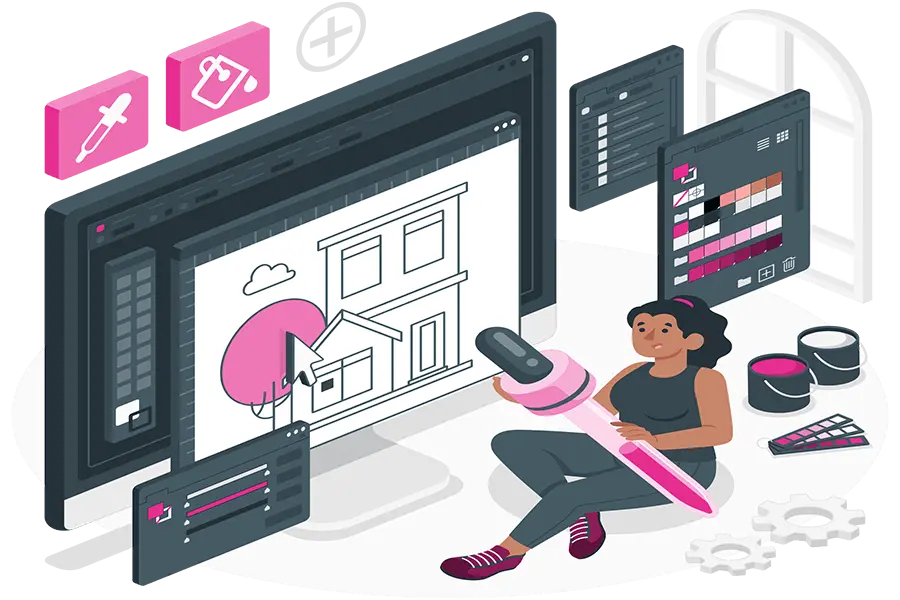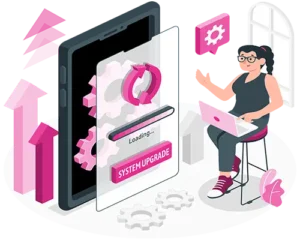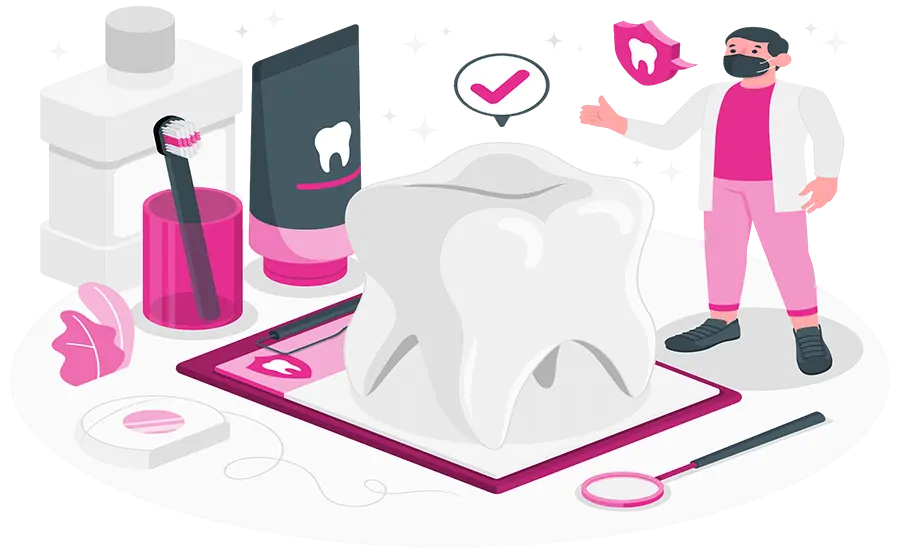Crafting a killer ecommerce logo design is about a lot more than just pretty colors and fun fonts. Your logo isn’t just a picture; it’s your brand’s best friend, building credibility, occupying a little perfect spot in potential customers’ brains, and, of course, convincing customers to click “Add to Cart.”
Make sure that the logo is an inseparable part of your brand’s soul. Make it pop, make it real, and watch that logo become the most rocking little part of the digital shopping experience.
I’ve had the same journey, and now I’ve made myself something of an expert. I am going to share with you guys the hacks of creating a perfect logo. Let’s start!
Table of Contents
Toggle5 Steps of Logo Development
1. Understand Your Niche
Before putting pixels on the screen, you must identify your core values and consumer profile. Are you a fun-loving boutique or the epitome of ultra-modern tech? Your design direction will be dictated by knowing your niche.
2. Competitor Analysis
Before designing a logo analyze this: Who are the main competitors in the market niche? Why are they better than you (or will be better)? What’s your difference (USP)? Do you like their logos? Why? Competitor analysis gives us an insight that helps us to avoid their mistakes and copy-cat ideas.
3. Tell a Story Through Shapes and Symbols
Select visual assets that tell the story of your brand and speak to your customers. Implementing clean lines depicts minimalism that conveys a sense of sophistication, whereas the use of fun type fonts sells the fact that this is a super fun brand to interact with.
4. Color Psychology
Do not underestimate the power of colors! Bold Yellow represents joy, while blues encourage belief. Select colors that fit in with your brand message and create an emotional attachment to it. Also don’t use too many colors in your logo
Here, I Am going to share some colors and the psychology behind them!
| Color | Psychological Association | Suitable for |
|---|---|---|
| Red | Passion, Energy, Urgency | Retail, Fashion, Clearance Sales |
| Blue | Trust, Stability, Serenity | Technology, Finance, Health |
| Green | Growth, Freshness, Calmness | Eco-Friendly Products, Organic Goods |
| Yellow | Optimism, Clarity, Warmth | Lifestyle, Entertainment, Creative Industries |
| Orange | Creativity, Enthusiasm, Playfulness | Food and Beverage, Art and Design |
| Purple | Luxury, Sophistication, Mystery | Beauty Products, High-End Fashion |
| Pink | Femininity, Romance, Sweetness | Beauty, Fashion, Lifestyle |
| Black | Elegance, Power, Modernity | Luxury Brands, Technology |
| White | Simplicity, Purity, Cleanliness | Health and Wellness, Technology |
| Gold | Prestige, Luxury, Success | High-End Products, Premium Services |
| Silver | Modernity, Innovation, Sophistication | Technology, Automotive |
| Brown | Reliability, Earthiness, Warmth | Outdoor Products, Natural and Organic Goods |
5. Design Different Concepts
Create different options with various colors, font types, and symbols. It can be several hundred. The point is to find as many options as possible and choose the best. Do brainstorming to find the most successful option. Later test the selected ideas with the target group, with the help of colleagues. Select the one that has a large number of votes.
2 Ways to Create Logos
1. DIY Platforms
For businesses looking to save money, online logo makers provide a rich selection of customizable templates. Keep in mind that select a site that provides SEO-friendly formats and only top-quality downloads.
2. Professional Designers
Although buying a corporate designer costs more, you are guaranteed an original logo that is carefully crafted to fit your brand and SEO objectives.
Also, check out Ecommerce SEO Services
ECommerce Logo Design Ideas
To remain updated, it is a must to know what design is trending when creating e-commerce logos. Be alert to what your competitors are doing, but don’t be timid to come up with innovations.
Here are some prevalent ideas:
Minimalism
Sleek, minimal logos are popular. They have a sense of modern delicacy and are ideal for e-commerce brands keen on portraying streamlined images.
Textual Logos
Textual logos, which can be classified as wordmarks or logotypes, use typefaces and styling of the name that a brand uses to generate an explicit image. These logos do not make use of symbols or icons but emphasize the artistic depiction of a brand’s name.
Graphical Logos
Graphical logos, which are also known as logo marks or symbols use images of visual elements and icons to represent a brand. However, these logos may be very efficient when it comes to communicating a brand identity and values.
Responsive Logos
In response to the growing adoption of mobile devices, one must make sure that his or her logo is responsive and looks good on different screen sizes.
Inspiration of Logos from the Champions
Let’s take a peek at how some e-commerce giants have mastered the logo game:
- Amazon: The arrow, which is an icon of their large inventory and fast service combined with the brand name.
- Apple: The bitten apple, which represents creativity and straightforwardness, has come to stand for the brand’s stylish and easy-to-use products.
- Etsy: The playful, hand-drawn logo reflects the platform’s focus on handcrafted goods and artistic expression.
But their success does not merely depend on the logo, they have strategically developed their brands through marketing, community building, and effective SEO.
You also deserve to be successful, Explore SEO services for e-commerce(E-commerce SEO page link)
5 Components of an Attractive E-Commerce Logo
Beauty is subjective, but certain elements make an e-commerce logo visually impactful and effective:
1. Simplicity and Memorability
A logo that’s too busy with too many elements can be confusing and disastrous. Instead, go for a simple yet memorable design so you’re etched in the minds of those who see it. The simpler the geometrical shapes, clear lines, and a minimum of distractive elements tend to be more effective.
2. Relevance to Your Brand
Your logo should be a visual representation of your brand. Use organic images and earthy hues if you’re selling sustainable clothing. If you’re a tech start-up, on the other hand, go with bright colors and geometrical designs to show that you represent innovative ideas.
3. Appropriate Typography
Fonts show your persona and tone. Choose a legible font, that harmonizes with your brand’s style, and translates to the right audience.
4. Effective Color Palette
Color affects emotions and perception. Pick a color scheme that represents your brand’s personality and is suitable for the needs of your target audience. Bright colors for example could symbolize vigor and fun and subdued tones could signify luxury and stability.
5. Versatility and Scalability
Your logo will be used in various sizes and formats therefore it needs to be malleable. Make sure it’s legible when viewed on phone screens, blown up on billboards and even embroidered on t-shirts.
Dos and Don’ts of Making E-commerce Logo
Creating an e-commerce log requires great effort and creativity. Here are some do’s and don’ts to keep in mind while designing a logo.
The Dos of Making E-commerce Logo
- Clarity: It indicates that the logo must be clear to be recognized right away by the people and it should be easily readable and recognizable.
- A unique element: This means that there has to be a unique idea, image, or logo that sets e-commerce apart from others in competition.
- Incorporation of relevant images or icons: Select the appropriate images or icons that pertain to the ecommerce business and help in making a logo that becomes eye-catching.
- Inclusion of a slogan or a tagline: For the sake of conveying the efficacious brand message and value proposition, the logo design must include a slogan or a tagline.
What Not to Do When Making E-commerce Logo
Here is a list of ways not to design e-commerce logos.
- Avoid creating a colored version first: Start with creating the black and white version of the logo to ensure whether it is possible without color.
- Do not use the same font for logo and website content: It suggests employing various fonts to maintain a professional and attractive design.
- Avoid blindly following design trends: Don’t rely on contemporary design trends that can become outdated very fast.
- Steer clear of vague or complicated designs: Formulate a readable and catchy logo that does not include complicated or ambiguous parts.
- Choosing the wrong font: Avoid choosing a font that does not reflect the personality of the brand or weakens the effect created by logo design.
4 Crucial Reasons Why E-Commerce Logo Drives Online Success
For online companies, the significance of an e-commerce logo cannot be stressed enough. Here are some key reasons why having a well-designed logo is crucial:
1. Brand Recognition
A logo is a brand’s visual identity. It allows customers to easily identify and recognize your business. A good logo that is consistent across all platforms and various marketing materials results in a powerful brand identity.
2. Professionalism and Trust
Your e-commerce business will be given a sense of professionalism by having a quality logo. It shows that you are a good and trustworthy company. When a brand appears professional and trustworthy, customers are more willing to engage in business with it.
3. Differentiation from Competitors
Today, in the busy online ‘environment’, it is crucial to be different from other competitors. A great logo makes your brand stand out among other businesses offering similar products and services.
It provides an opportunity for you to have a unique brand identity that distinguishes itself from others belonging to the same industry.
4. Attract Customers
An attractive logo is the one that attracts potential customers. First, it is desirable because a good logo design can keep your brand in mind for a long time.
Please Note: Keep in mind that even if you start with a perfect logo design, an Ecommerce business is a long-run game. Let’s check out how much time e-commerce business requires to make money.
FAQs
What is an E-Commerce Logo?
E-commerce logo is your brand identity that reflects your brand’s personality and increases the credibility and authority of your brand.
How Do I Create a Logo for My Business Online?
You can create a logo for your business either by utilizing DIY platforms or hiring a professional graphic designer or agency.
Wrapping Up
Summing it up, to make a great e-commerce logo, first recognize who your audience is. Second, keep up with design trends. Moreover, analyzes successful brands in recent history for inspiration. Choose something practical for you to follow.
Saying that after a good design logo not only feels comfortable to see, but it is also an effective weapon in winning the trust and rebuilding a long-lasting brand image among the fierce virtual competition.









